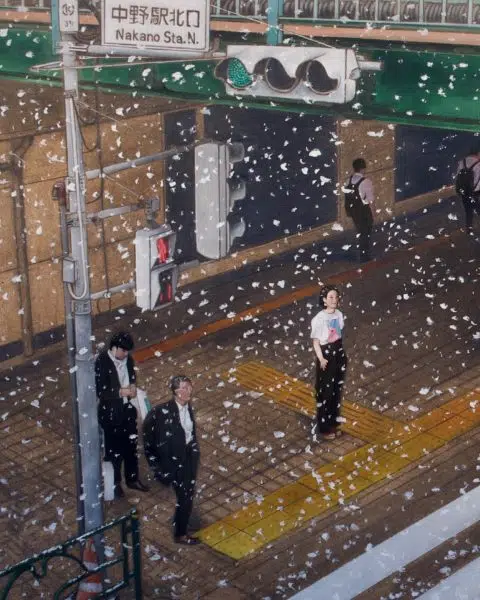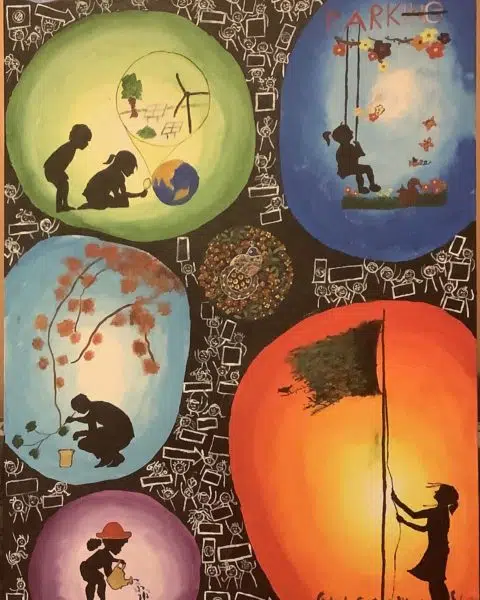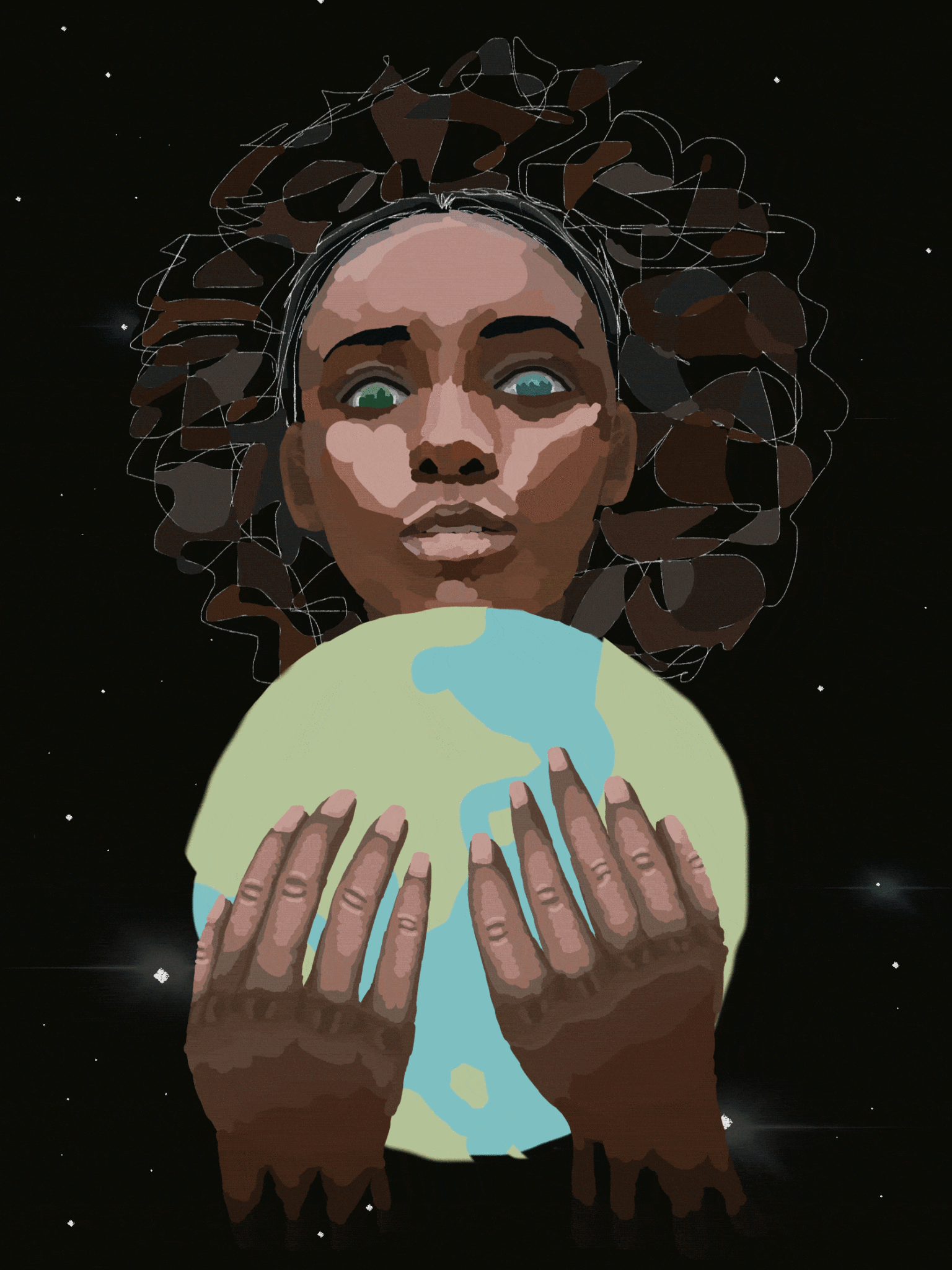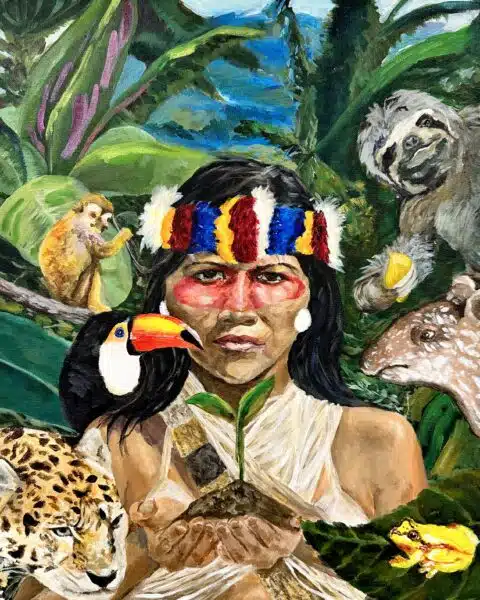Contest Overview
The 14th annual Ocean Awareness Contest is a platform for young people to learn about environmental issues through art-making and creative communication, explore their relationship to a changing world, and become advocates for positive change. Students ages 11-18 from around the world are invited to participate.
2025 Theme | Connections to Nature: Looking Inside, Going Outside
A CREATIVE CHALLENGE FOR TEENS WORLDWIDE
Connections to Nature: Looking Inside, Going Outside Prompt
The 2025 Ocean Awareness Contest – Connections to Nature: Looking Inside, Going Outside – encourages you to explore the natural world and your place in it. We invite you to think about your unique connection to nature and how being outside makes you feel. There are so many different ways that you can connect to nature, whether that’s exploring the history of the land you live on, volunteering in the fight against climate change, or taking a restorative walk in your local park. Go through the sub-themes and explore the topics that resonate with you. Share your relationship with the natural world through art, writing, performance, film, or multimedia. What is your connection to nature?
The Contest deadline is June 9, 2025.
Contest winners will be announced by December 1, 2025.

A NEW CHALLENGE
Last year, we asked you to tell your climate story – your personal experiences, insights, and perceptions about our changing climate reality. Your connection to nature may relate to your climate story, but there’s so much more to nature than climate change! We challenge you to dive into this year’s theme and explore your connection to the natural world through the lenses of:
- Generational Knowledge
- Concrete Jungle
- Resilience
- Healthy Environments, Healthy Humans
We hope that these sub-themes can serve as jumping off points, prompting you toward further exploration! Be sure to check out our past winners and explore our broader Resource Studio for ideas and guidance.
Our Resource Studio is a unique space for creative exploration and a jumping-off point for deep inquiry of climate change, ocean conservation, and using art and creativity as tools in environmental movements.

Family histories, struggles, successes, and privileges can be deeply connected to land and nature. How has nature played a role in your life and the lives of your ancestors? What meanings and associations does nature hold for your family, your community, or yourself? We encourage you to explore emotions, aspirations, or challenges related to nature that are part of your family’s history.
Broad historical and societal shifts have shaped how we relate to nature. Colonization and industrialization have forever changed landscapes and deepened the divide between people and the environment. In many Western philosophies, humans are often viewed as superior to nature, further fueling this disconnection. However, many Indigenous cultures recognize humans as part of a larger, interconnected ecosystem. Indigenous communities, who have been stewards of the land for centuries, offer invaluable lessons on sustainability and environmental balance. Look into the Indigenous communities in your area – how have they been affected by environmental changes, and what strategies have they used to live in harmony with the natural world for generations?
According to the United Nations, over half of the world’s population now lives in cities and towns, and this number is expected to reach nearly 5 billion by 2030. While they may seem worlds apart, urban and natural environments are deeply interconnected. Cities rely on natural ecosystems for resources like clean water, air, and food, while natural areas are impacted by the waste and pollution generated by urban centers. This relationship is a constant exchange, with urban development often encroaching on natural habitats, but also creating opportunities for conservation through green infrastructure and sustainable design. Parks, urban forests, and green roofs offer vital spaces for wildlife to thrive and for people to connect with nature within city landscapes. These initiatives highlight the potential for cities to coexist with nature, rather than stand in opposition to it. How do you see the relationship between your urban environment and the natural world? What innovative ways could cities and nature grow together in the future?
Human activities are driving rapid environmental changes, from rising sea levels to shrinking forests, and today’s world looks very different from just a decade ago. To address these shifts, building environmental resilience is key. Environmental resilience takes many forms, each crucial for helping ecosystems recover from and adapt to ongoing challenges. From reforestation efforts that restore damaged forests to creating wildlife corridors that connect fragmented habitats, resilience can be seen in both large-scale conservation projects and small community initiatives. On a more local level, actions like planting native species, conserving water, and reducing plastic use all contribute to the ability of ecosystems to withstand stress. Even urban areas can foster resilience through green infrastructure, like permeable pavements and rain gardens, which reduce flood risks and improve water quality. In what ways can you help build environmental resilience in your community? What creative strategies could be used to strengthen the connection between people and nature in the face of ongoing environmental challenges?
Spending time in nature has been shown to significantly boost mental wellbeing, offering benefits like improved focus, reduced stress, a better mood, and even greater empathy and cooperation. Whether it’s a walk in the park or a moment by the ocean, connecting with the natural world has a grounding effect. Research links time outdoors with reduced anxiety symptoms, and even short periods outside can enhance your overall sense of well-being. How do you feel when you spend time in nature? What about when you’re disconnected from it? Have you noticed changes in your mood, stress, or mental clarity?
Beyond mental health, nature also has a positive impact on physical well-being. Studies show that spending time outdoors can lower muscle tension, reduce blood pressure, and decrease the risk of cardiovascular disease. Exposure to sunlight helps increase Vitamin D levels, essential for healthy bones, blood cells, and a strong immune system. What role does your local environment play in supporting or challenging physical health?

Smithsonian Creativity in Resilience Award
Bow Seat is thrilled to announce a new award for the 2025 Ocean Awareness Contest in partnership with the Smithsonian Institution. The Smithsonian Creativity in Resilience Award recognizes exceptional work across all creative art categories that exemplify the Contest sub-theme of Resilience. 10 $250 awards in both the Junior Division (ages 11-14) and Senior Division (ages 15-18) – a total of 20 awards – will be offered.
Submissions in any category from any country will be eligible for this award, to be selected by judges from the Smithsonian.
Selection for this award does not preclude participants from being considered for any other Bow Seat Contest award.


United by Nature “Author’s Spotlight”
Exciting news! This year, U.S.-based students who participate in the Ocean Awareness Contest in any category will automatically be considered for a United by Nature “Author’s Spotlight”. Bow Seat will select 20 entries to be featured and paired with themes in the groundbreaking United by Nature report by its writers.
The United by Nature report, formerly known as the National Nature Assessment, aims to take stock of U.S. lands, waters, wildlife, and the benefits they provide to our economy, health, climate, environmental justice, and national security. The report will also look ahead at how nature might change in the future, and what those changes may mean for our economy and our lives. It will be published in 2026.
Selection by Bow Seat for this chance to be a part of raising awareness about the United States’ nature and the environment will not preclude anyone from consideration for other Bow Seat awards.
“People can’t understand the world as a gift unless someone shows them how it’s a gift.” – Robin Wall Kimmerer

Who May Enter
Students ages 11-18 from around the world are invited to participate in the Ocean Awareness Contest. Enter the division based on your age at the time of entry:
- Junior Division: Age 11-14
- Senior Division: Age 15-18
Students can participate as an individual or as a club, class, or group of any size. All students must provide the contact information for an Adult Sponsor (teacher, parent, mentor, etc.) Students who have started college or university are not eligible to participate in the Contest.


Submissions are accepted in:
- Visual Art: Handcrafted
- Visual Art: Digital
- Poetry & Spoken Word
- Creative Writing
- Film
- Performing Arts: Music & Dance
- Interactive & Multimedia
Please review all submission requirements carefully.
CONTEST DEADLINE: JUNE 9, 2025
How to EnterWhy participate?
- Join Bow Seat’s global movement of over 38,000 young creatives who care about the ocean, environmental justice, and climate action, and contribute to the largest youth environmental arts collection in the world.
- Gain knowledge about environmental issues, nature, and your relationship with the world around you. Dive into Bow Seat’s Resource Studio to learn more about the issues; find artists and organizations taking action to protect our blue planet; and discover ways that you can get involved.
- Grow your skills in communication, critical thinking, creativity, and environmental advocacy. Use your artwork to raise awareness for critical environmental issues.
- Build your portfolio and make art in your preferred medium, or practice a new one! Add to your resume with a participation certificate.
- Showcase your talents worldwide. Through art exhibitions, publications, social media campaigns, and scholarships, Bow Seat uplifts diverse youth voices to advance dialogue and participation in environmental conservation and advocacy.
- Be eligible for special opportunities, like the Future Blue Youth Council. Past program participants also serve as Bow Seat interns and Contest judges!
- Earn cash awards of up to $1,000!
